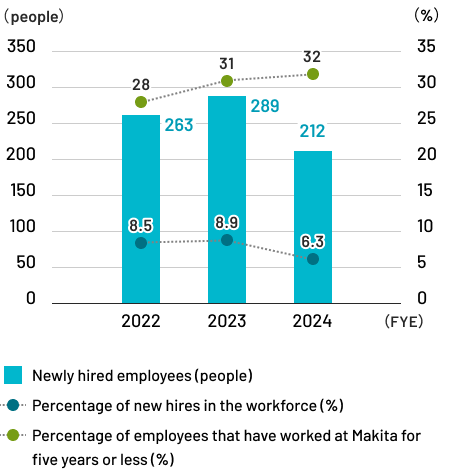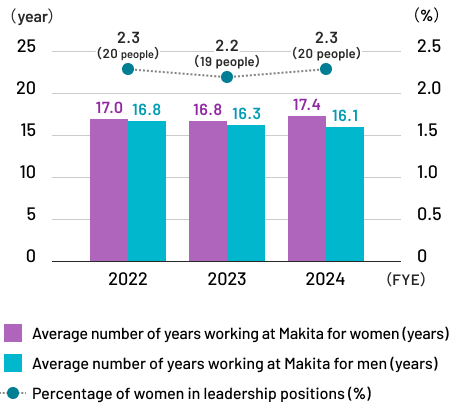Human Capital
Strategy for Human Capital
Since Makita’s expansion into the U.S. in the 1970s, the Company has pressed forward and proactively grown internationally. In 2005, we launched our lithium-ion battery-powered professional-use cordless tools ahead of the competition and, more recently, with environmental issues globally growing into an important theme, we have been working towards evolving into a supplier of a comprehensive range of cordless products by shifting from engine-powered to battery-powered products. This ability to flexibly respond to global market environment changes is the source of Makita’s growth. What supports our growth is nothing other than the talents of the people working at Makita.
Moving forward, Makita will comprehend changes in the global market environment and strive to grow with demand. To this end, we will advance the activities of diverse human resources and globalize Makita.
Efficiently Training New Human Resources to be Competitive as Quickly as Possible
Makita is expanding its business on a global scale, and many of its employees have experience temporarily working or training abroad. As of March 31, 2024, approximately 26% of employees, excluding those working at the Research and Development Headquarters or Domestic Sales Headquarters, have worked overseas on temporary transfers. For Makita to continue to grow sustainably, it is essential that newly hired human resources (both new graduates and mid-career employees) with diverse values gain international experience early on and receive training to be globally active. We are working to achieve the target we have set of 20% of employees sent for overseas training or temporary transfer having worked at Makita (non-consolidated) for five years or less by March 31, 2030.
In FYE 2024, the number declined temporarily because the majority of young employees sent overseas who have been working at Makita for five years entered their sixth year. At the same time, we introduced a short-term overseas training system, so an increasing percentage of our workforce now has overseas training experience. After finishing the training, they spend several months to a year in Japan on preparation, which leads to successful subsequent overseas assignment.
To achieve our target, we will utilize short-term training programs to increase the number of young employees who are eligible for overseas work.

Indicators
| | FYE2022 | FYE2023 | FYE2024 | FYE2030 |
|---|---|---|---|---|
| Percentage of employees sent for overseas training or temporary transfer that have worked at Makita for five years or less | 17% | 14% | 12% | 20% |
Initiatives for achievement
- Proactively accepting internships and building relationships with university laboratories to lay the groundwork for attracting excellent human resources
- Launching short-term overseas training programs to enable more young employees to gain overseas experience
- To foster international career development and increase motivation amongst young employees, we held a roundtable discussion with employees with overseas work experience and shared the content in the Company newsletter.
New Hires

Promoting Women’s Advancement
Makita is working to create an environment that is comfortable for women to work in and allows human resources with diverse values to demonstrate their abilities to the fullest. As a result, the average length of female employees working at Makita in Japan is actually slightly higher than that of their male counterparts.
We have set a target for the future to increase the percentage of female managers at Makita (non-consolidated) to at least 3% (10 or more people) by FYE 2030, so that every female employee can play a more active role, and we are advancing our efforts to achieve this target.
In FYE 2024, we held the Women’s Career Design Seminar over two sessions for interested female employees. Seminar participants reflected on their lives, identified their strengths and unique abilities, and created action plans for the future. At the second session, Ayumi Ujihara, Outside Director, spoke on stage, sharing her perspective as an experienced working woman about such subjects as looking at things positively, enjoying work, and networking.
Participants said that this was a good opportunity to think deeply about their own career development, and we will continue to implement measures to promote the active participation of female employees.


Indicators
| | FYE2022 | FYE2023 | FYE2024 | FYE2030 |
|---|---|---|---|---|
| Percentage of female managers | 0.7% (2 people) | 1.0% (3 people) | 1.3% (4 people) | 3.0% or more (10 or more people) |
Initiatives for achievement
- Creating systems that allow flexible work styles, such as through the expansion of the childcare reduced working-hours system
- Actively recruiting female new graduates and mid-career hires
- Encouraging women to take the exams for promotions to leadership and management positions
Average number of years working at Makita by gender/Percentage of women in leadership positions




Encouraging Employees to Take Childcare Leave
Creating a rewarding environment that allows human resources with diverse values to balance work and family is vital to Makita’s continuing growth.
We have put in place a childcare leave system and a childcare reduced-working-hours system.
The percentage of women who use these systems has remained high, but the percentage of men using them has room to improve. Therefore, we have set a target of having at least 90% of eligible male employees at Makita (non-consolidated) use the childcare leave system by FYE2030 and are working towards achieving this goal.
Indicators
| | FYE2022 | FYE2023 | FYE2024 | FYE2030 |
|---|---|---|---|---|
| Percentage of male employees using childcare leave system | 8% | 25% | 49% | 90% or more |
Initiatives for achievement
- Making information on childcare leave available to workplace managers to promote the creation of an environment that encourages employees to use childcare leave
Reference
| | FYE2022 | FYE2023 | FYE2024 |
|---|---|---|---|
| Percentage of female employees using childcare leave system | 92% | 100% | 100% |
